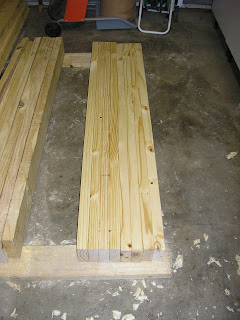Since my last post, there has been much activity (spot the understatement!):
- Stock for the legs was machined and laminated; the tenons at the top of the legs were formed at the time of lamination
- The stretchers were made in a similar fashion
- The chop for the leg vise was laminated
- The handle was turned for the leg vise
- The parallel guide for the leg vise was machined and drawbored into a mortise in the chop
- Mortises were cut in the legs and the top for assembly
- The legs and stretchers were assembled and the joints drawbored and glued
- The top was assembled to the leg / base assembly and the mortise and tenon joints were drawbored and glued
- The sliding deadman was laminated, shaped and the holes drilled
- The support peg was turned for the sliding deadman
This bench is AMAZING. Effortless workholding means I can focus on getting the tools to do the job they were intended to do instead of focusing my efforts on preventing the workpiece flying around. This has made a HUGE difference to the way I work - and has improved the accuracy of my work no end.
I estimate the overall mass at around 100kg (±220lbs) in its present form - perhaps not as much as I had hoped for initially. Still, this is a phenomenal improvement over the collapsible "bench" that has served me to date.
Still to do:
- I need to apply a finish to the bench
- I need a series of dog holes through the top - but I'm holding off on drilling them until I'm confident at what will be their ultimate placement
- I need to make a shelf for the base. This will serve the purpose of providing decent storage below the bench as well as adding to the overall mass of the bench. This is a GOOD thing - believe me!
- I'm probably going to cobble together Chris Schwarz's Tool Rack with some minor variations to suit my shop.
I repeat - I really am no good at this whole blogging thing!
I do however promise to try and make an attempt to keep updating with progress on the dovetail front!













